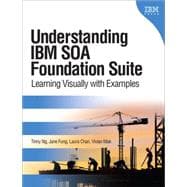Understanding IBM SOA Foundation Suite
Learning Visually with Examples
Master the IBM SOA Foundation Through 26 Hands-On, Start-to-Finish Tutorials
The IBM SOA Foundation Suite is an integrated, open-standards-based set of software, best practices, and patterns that help you systematically maximize the business value of SOA. Understanding IBM SOA Foundation Suite brings together 26 hands-on tutorials that will help you master IBM SOA Foundation and apply it successfully in your organization. Four of IBM’s SOA practitioners identify core IBM SOA Foundation components and usage scenarios, and walk you step-by-step through implementing them in real-world environments. This book’s self-contained tutorials are presented both in print and through video on the accompanying CD-ROM, showing you the results of every action immediately, whether you’re running the software or not. Using these tutorials, technical professionals can quickly move up the learning curve, discovering how each product works, and how they fit together. You’ll gain the big picture overview you need to make intelligent up-front decisions, and all the hands-on practice you need to prototype working solutions.
Coverage includes
- Designing services with UML, sharing designs via HTML files, and transforming designs to and from Java with IBM Rational Software Architect
- Creating services with IBM Rational Application Developer, and deploying them with IBM WebSphere Application Server
- Implementing effective service governance with IBM WebSphere Service Registry and Repository
- Integrating existing services into new business processes with IBM WebSphere
- Integration Developer and IBM WebSphere Process Server
- Connecting services with IBM WebSphere Message Broker
- Developing, testing, deploying, and managing portlets with IBM WebSphere Portlet Factory and IBM WebSphere Portal
- Systematically securing services with IBM Tivoli Federated Identity Manager








